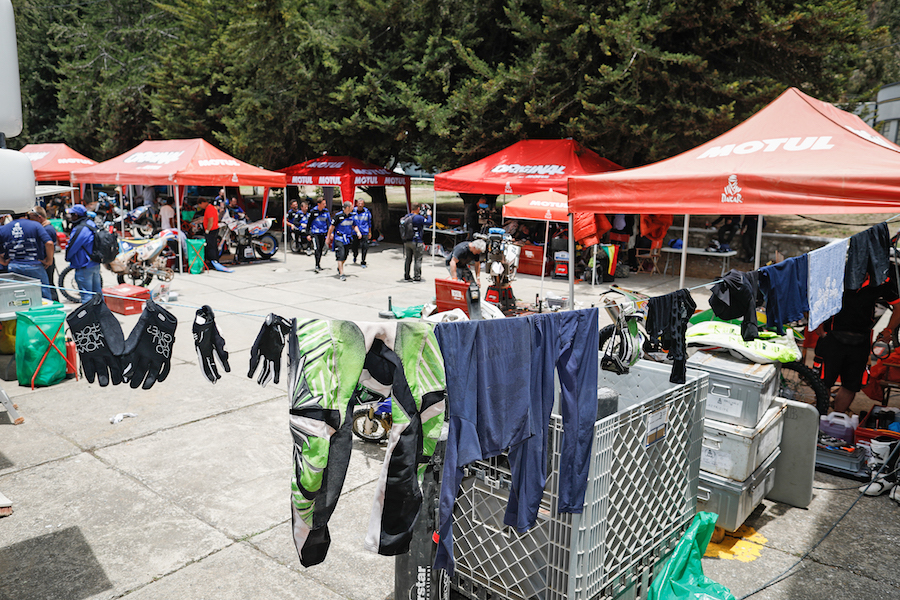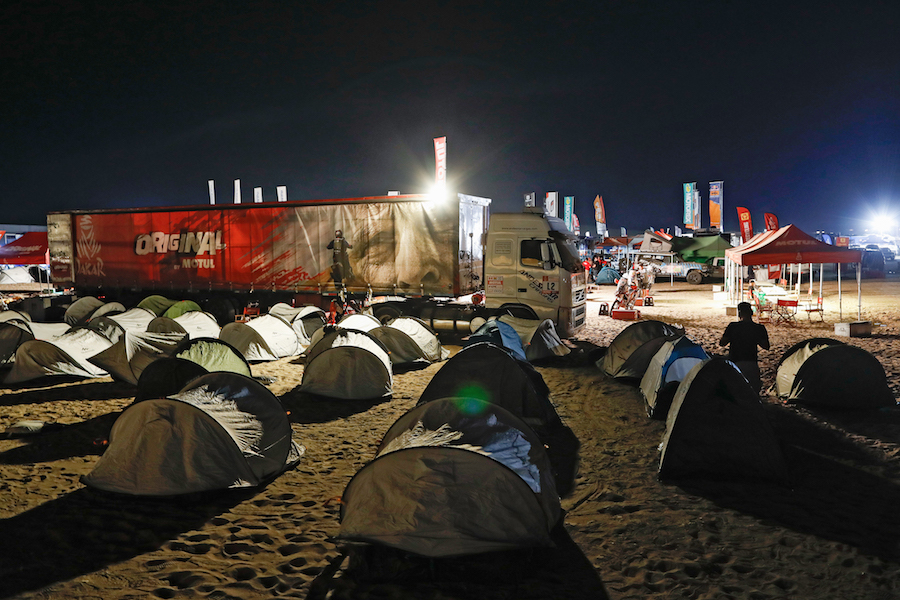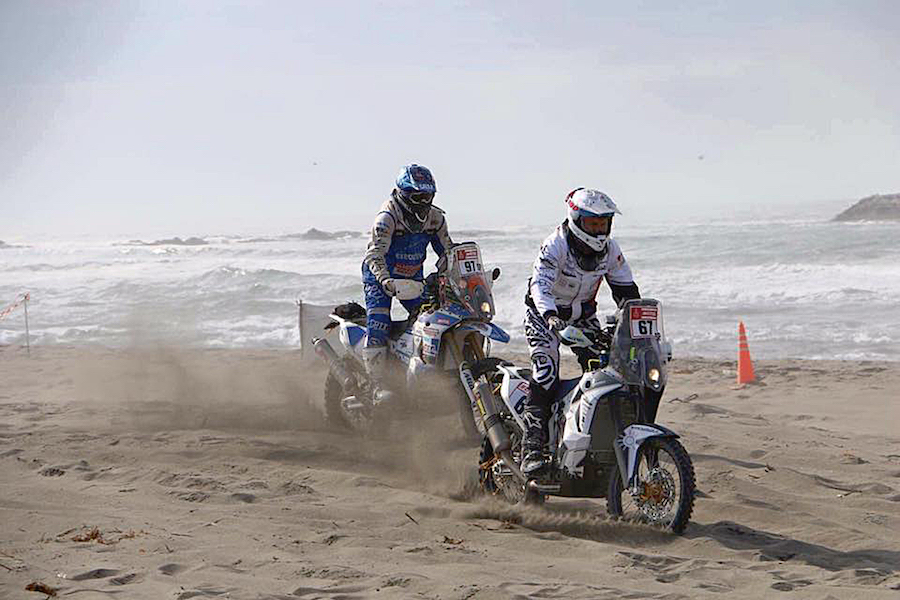What if there was a way to make the punishing Dakar Rally even harder?! There is - Aussie rookie Scott Britnell went and did it
The Dakar Rally is arguably the world’s longest, toughest and most challenging off-road rally. The race is held in South America and for the 40th edition it traversed 9000km across three countries. Peru, Bolivia and Argentina provided their own geographical challenges for the competitors, including massive dunes, rocks and of course the extreme altitude of the Andes.
Finishing this race is a challenge in itself, so why would Scott Britnell from Bowral, NSW enter the event for the first time in the Original by Motul (formerly known as Malle Moto) class?
For the uninitiated, Malle Moto competitors ride and maintain their own bike for two weeks. No motor homes, no mechanic, no masseuse, no support. Just man and machine against the elements, the environment and, of course, the clock. Referred to these days as Dakar Originals, this type of competitor is reminiscent of the very first Paris-Dakar Rally riders.
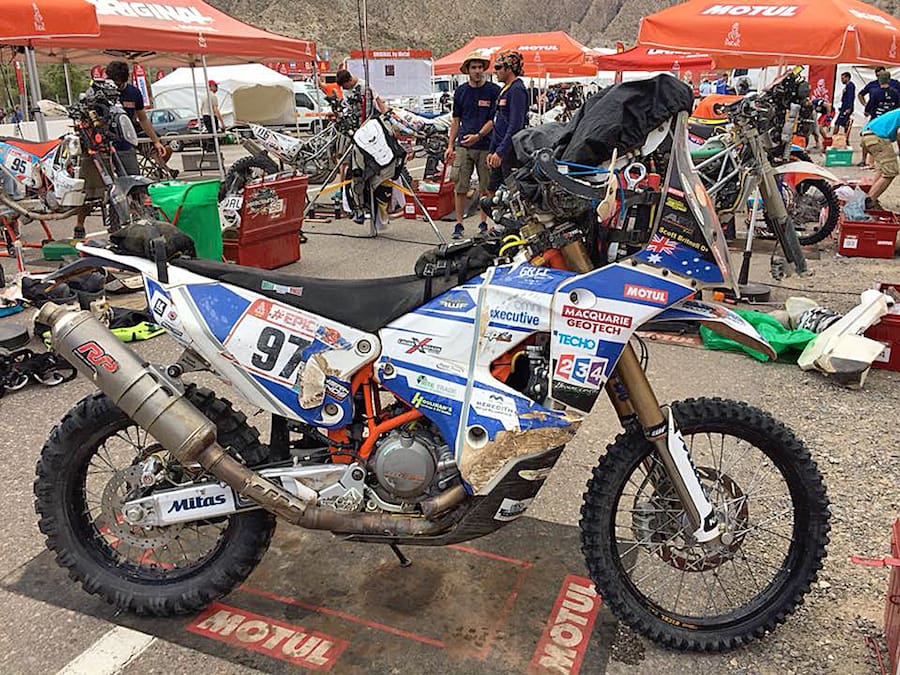
Scott Britnell took an interest in desert racing before he even had a licence. Watching John Hederics in the Wynn’s Safari ultimately led him to have a shot in the 2003 Australian Safari. Eleven years later Britnell broke the record for crossing Australia in just 72 hours and 10 minutes, obliterating the previous record by over 20 hours.
The man from Bowral needed another challenge to conquer and set his sights on the 2017 Dakar Rally. And not just any Dakar attempt; he was hell bent on competing as a fully self-supported and self-funded solo effort in Malle Moto.
Britnell’s two-year plan to tackle the greatest race on Earth took a blow in 2016 when an attempted double crossing of the Simpson Desert in a single day resulted in a whopping crash that left him with nine broken ribs, a punctured lung, torn shoulder ligaments and another year of Dakar preparation.
After a long and hard-fought recovery, he set about making sure his new bike was race-ready and all the associated paperwork was in order for the 2018 Dakar Rally. But the plan to ship his bike from Australia to Europe in late 2017 hit a hurdle just a week prior to heading to the docks.
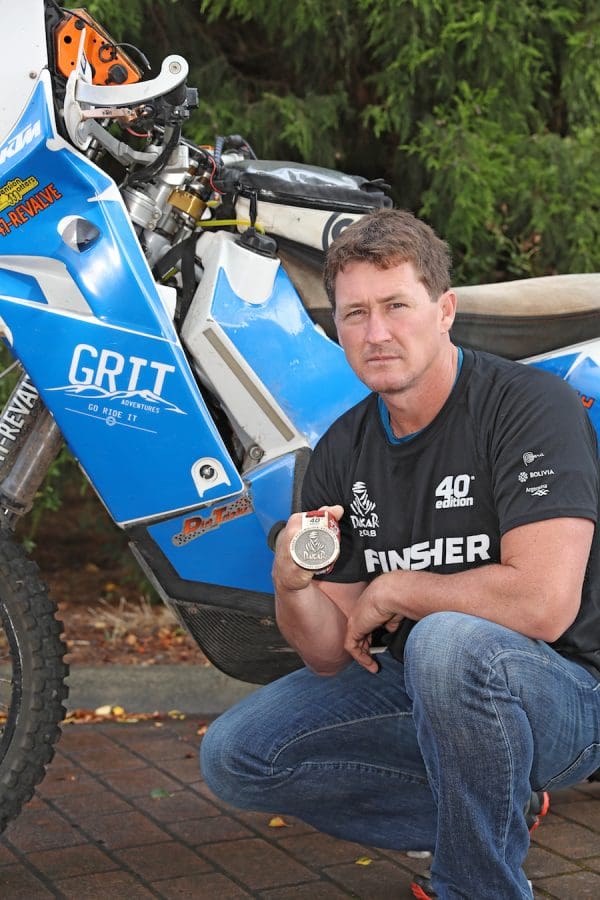
“A miscalculation on the number of tyres I’d require meant they couldn’t be shipped direct from the factory to meet the bike in South America,” he said. “And with no local dealer in Lima, Peru, I was forced to take my tyres with me from Australia, as excess baggage!”
In order to acclimatise to the extreme altitude and reset his body clock, Britnell arrived in Cusco in the Peruvian Andes a week before the event kicked off. The city sits 3400 metres above sea level and day trips to altitudes of over 4000 metres helped both his physical and mental preparation.
With some assistance from friend Trevor Wilson (another willing tyre mule from Australia), Britnell was able to finish the preparation of his gear and get his bike through the arduous task of scrutineering. Now just 9000km in 14 days lay between Britnell and the finish in Cordoba. But the wide-eyed rookie was up for the challenge.
The opening stage was a great icebreaker and a chance to finally ride the bike with its full navigation kit fitted for the first time. Scott honed his rookie navigational skills quickly and finished the day 44th out of the 137 motorcycle competitors.
The second stage was the first real challenge and, although the day went well, dropping to 100th place indicated just how hard this year’s course was. Some 11 bikes didn’t make the finish line that day, so just to complete it was an achievement.
But it turned out the organisers were just warming up. The third stage was extremely taxing on all competitors. The massive and soft dunes caught out many rookies and took the seasoned competitors by surprise as well. All sorts of vehicles – huge trucks, top-spec rally cars, the quads and plenty of bikes – were strewn throughout the soft sand dunes as Britnell picked his way through.
Those dunes claimed more than 20 competitors, and for the tough Aussie this was a reality check. Time to stop focusing on racing and keep his objective front of mind – make it to the finish, taking it one day at a time.
At one point he found himself stuck in a sand bowl, only 15 metres from its crest. Two car drivers attempted to help, but not even three men could persuade the KTM any further up the dune. In the end, and after a 20-minute rest, Britnell accelerated his 450 towards the bottom of the bowl, hoping like hell he could build enough momentum to get out the other side. It worked.
However, an hour later, while ascending a steep dune, he came across a Bolivian quad competitor stuck and begging for assistance.
‘I have enough struggles of my own,’ Britnell thought. ‘But will helping this guy really make a difference to my result over the next 10 days?’
With that, the Dakar spirit triumphed and he stopped his bike. He walked 20 minutes up the offending dune and gave one very appreciative Bolivian rider a helping hand.
You cannot prepare for everything and Stage Three gave the plucky Aussie a taste of Dakar’s notorious bad luck. His lower fork tube unscrewed from the cast axle holder and, to use Britnell’s own words, was “pissing oil bad”. The next few hundred kilometres were punctuated by regular stops to hand-tighten the fork leg – another addition to the growing list of mechanical issues he’d need to do by himself that night when he reached the bivouac.
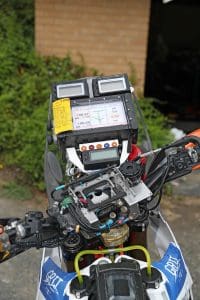
But on the start line of the fourth stage the following morning, Britnell was smacked with the far-too-late realisation that between fatigue and haste, he’d overfilled the fork leg with oil the
previous night. With less than a quarter of the normal suspension stroke available, he was forced to start the race and paid the price.
“The first lump I hit threw me clean off in a pile of dust,” he recalled. After 100km of punishment, he pulled the top bleed screws out and hand-pumped as much fork oil out as possible in a bid to continue the race with something that resembled motorcycle suspension.
Thankfully, the next few days were kinder. He’d found his groove, he was riding well and doing his best to manage the overwhelming fatigue and sleep deprivation. Like every other competitor, he was looking forward to the rest day, but unlike team riders his entire so-called rest day would be taken up by bike maintenance in preparation for the even tougher second week.
Stage Seven tossed up more dunes and extreme altitude, mostly above 4500 metres. Torrential downpours made the lower tracks muddy, slippery and waterlogged. Falling off the bike was par for the course and added to everyone’s growing fatigue.
The following day was more of the same taxing terrain, altitude and more and more mud. There were some relieved competitors when the decision to cancel the ninth stage was announced.
The final few days went without incident for the tough Aussie. He was able to hold his positon and ride his own race.
The last day, however, brought emotion. Not because of the end of the Dakar, but Scott was less than impressed with the reverse-order starts on dusty trails, which meant 120km of sketchy riding in thick dust. At the finish line Scott just wanted to vent his frustration with a fellow rider. He turned to a young French rider and began talking, then realised the young guy was crying, emotional at achieving his long-term dream. The frustration faded as Scott now realised that he too had finally achieved his three-year goal.
The 43-year-old rookie finished 10th in the Original class – of which only 16 riders finished – and ended the two-week event in 61st overall from the 85 motorcycle riders who made it. For a bloke who’s twice the age of some Dakar riders, his peformance was an impressive display of mental mettle and physical capability.
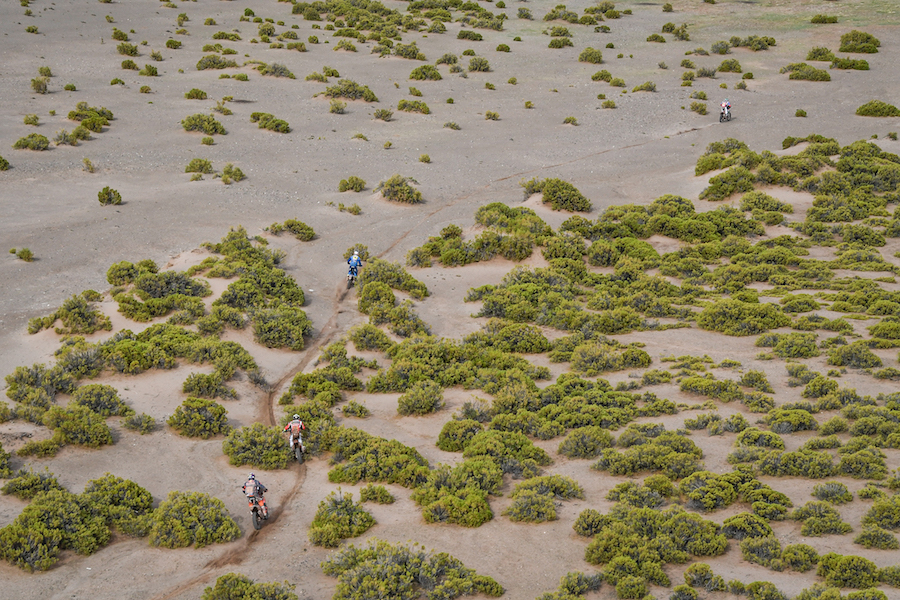
The Dakar ‘course’ is generally more like a suggestion…
A privateer’s rally bike
To give himself the best chance of finishing this gruelling event, Britnell parted with some serious coin to buy a KTM 450 Rally Replica.
Limited numbers are produced each year, specifically for rally raids and hardcore events like the Dakar. Complete with GPS and Sentinel brackets, it is possible to turn up to the Dakar with one of these machines and race it straight out of the box.
But Scott knows the value of bike preparation and familiarisation. He set about checking every nut, bolt, wire and electrical connection on his new investment. He also added a few heat shields to some known problem areas such as fuel tanks and bash plate.
The hours spent in the shed at home meant he could go into the race as an unsupported rider with confidence in both his machine and his technical ability to maintain it during the gruelling two-week race.
Would he do it again?
“Based on the joys of riding Dakar, yes I would. Absolutely! Will I? Well, you should not ask anyone that question before Easter! Let’s say it’s on my ‘possibly’ list, but the financial burden it places on a privateer means it won’t be in a hurry. It is just too big an outlay without some major sponsorship.
“In the meantime, I have plenty of projects to keep myself occupied and I might consider the Africa Eco Challenge. Next year, I’ll head back to Mongolia for another GRIT Tour and will also take in the Mongolian Rally after the tour.
“But if I did head back to Dakar, I’d use the knowledge gained this year to push for a podium position.”
And that sounds like a new challenge if ever we heard one.
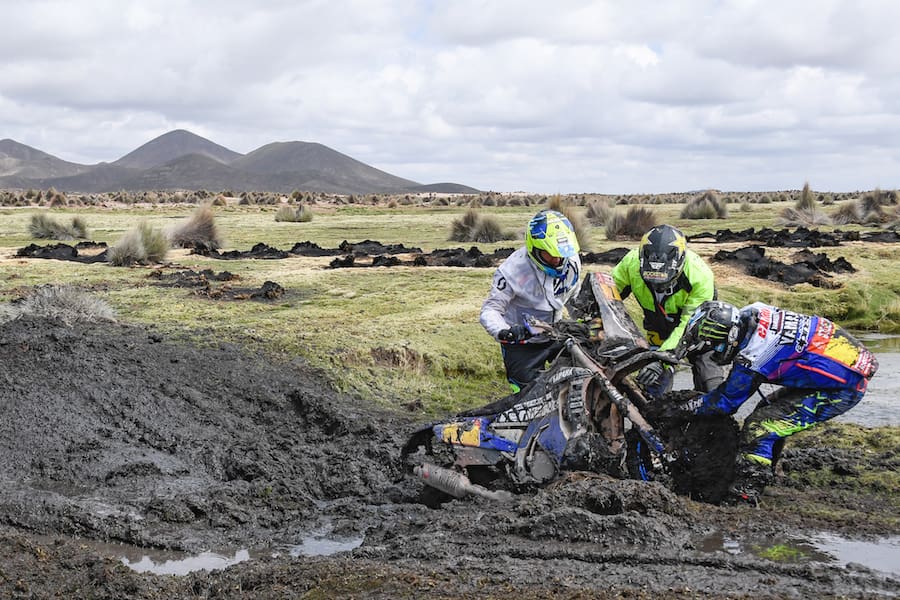
Best, worst, funniest… The highs and lows of Scott Britnell’s Dakar odyssey
Best moment
“There were plenty of enjoyable moments during the race, like chatting with other riders and new friends, but without a doubt the best moment was crossing the finish line. Until then, there was always the self-imposed pressure of ensuring my bike and myself were ready for the next day. Each day for two weeks is focused on riding and getting through the stage. I was always conscious that it could all go bad, right up to the last minute of the race. This was a three-year project that came to fruition as I finished the final day. Once I finished, I could mentally tick that box; I had achieved what I set out to achieve. It was a solitary moment though, with no family or crew to share the success with. I couldn’t even call my wife Christan as I didn’t have a phone with me.”
Worst moment
“Sitting on the bike at the beginning of the fourth stage, ready for the beach start and realising I had put too much oil in the fork the night before. I sat there with a big lump in my guts, thinking ‘you idiot!’ I was in for a hell of a day knowing I was only going to have two inches of suspension travel for the entire day. I didn’t have the tools, nor the time to remedy my mistake in the five minutes I had before my race started. I did not realise how bad it would actually be until I started racing. After 100km of fighting the bike through the rocks, I stopped and pulled the bleed screws out of the top of the forks. I pumped the suspension, showering myself and the bike with excess oil until I couldn’t get any more out. It was not enough but made the bike rideable for the rest of the day.”
Funniest moment
“I had some great moments during the event but there is one particular thing that for some odd reason makes me laugh every time it happens. Despite riding several events in dunes, it is often difficult to see the very soft sections of sand which the front wheel can rapidly descend into. The dunes in Peru were littered with soft portions that bring you to a rapid halt and you do a cartwheel over the handlebars and land on your back. I don’t know why, but I just laughed every time I did it! I knew it wasn’t going to hurt but it also meant I was going to take five minutes to get the bike out of the sand. If anyone was watching, I am sure they would see the funny side, just like I do. If you are going to have a spectacular crash, I recommend soft sand!”

Words Max Sullivan Photography AMCN archives & M

